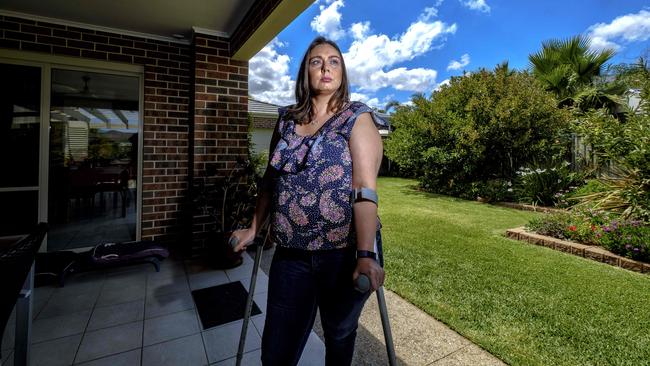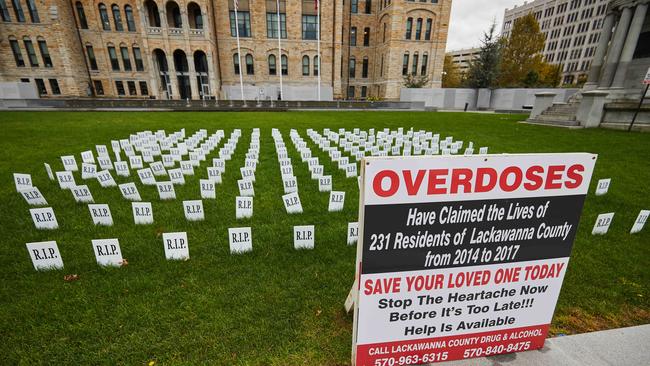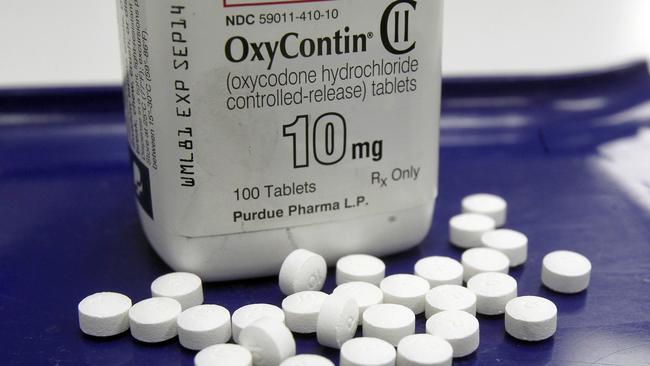Fine line between relief and craving in opioid war
Sufferers are caught in the crossfire in a war on opioids, yet there are a lot of other ways to manage pain.

Natalie Elliott is fed up with being treated like a drug addict.
The 35-year-old, from Werribee in Melbourne, has endured a range of serious medical conditions for most of her life, including the incurable chronic regional pain syndrome and severe degeneration in her neck vertebrae that requires a spinal fusion, as well as herniated discs and a compressed spinal cord.
Without opioids, she has trouble walking, showering, sleeping, sitting and leaving the house. Yet although she is happy with her current doctors, she has had trouble in the past.
“One pain specialist told me that opioids would only make my pain worse, so I should wean myself off the medications,” she says.
“When I asked if there were alternative options, such as ketamine infusions and medicinal cannabis, he told me that they do not work. I asked what could he do to help relieve my pain and he said ‘nothing’.”
Over-the-counter sales of certain codeine drugs (also opioids) ended last week and the Therapeutic Goods Administration has released a discussion paper on prescription opioid use and misuse in Australia.
Levels of opioid overdose are at record levels in Australia and internationally, the TGA’s discussion paper says, suggesting possible regulatory reforms to minimise opioid damage, including reducing pack sizes and considering “whether the highest dose products should remain on the market, or be restricted to specialist prescribing”: in other words, preventing GPs from prescribing the highest dose opioids.
Behind these dry words is the unfolding horror in the US, where an opioid crisis is killing more than 100 people a day, leaving thousands of children orphaned and reducing the average life expectancy in the world’s leading democracy.

Donald Trump yesterday committed $US13 billion ($16.5bn) in new money in his proposed 2019 budget to fight the opioid epidemic. The US National Institute on Drug Abuse says more than 115 Americans die from opioid overdoses every day.
Australia prescribes fewer opioids than the US (about 40 per cent proportionally), yet authorities here are concerned by steady increases in the drugs’ use, noting that since the end of 2009 there has been a general increase in prescriptions, from about 10 million annually to 14 million annually. Australia now ranks eighth in the world in terms of pharmaceutical opioid consumption.
According to the TGA discussion paper, pharmaceutical opioid deaths in Australia are double heroin deaths, in a reverse of the proportions seen in the 1990s. Between 2011 and 2015, there were 2145 deaths in Australia associated with the opioids oxycodone, morphine, codeine, fentanyl, tramadol and/or pethidine, compared with 985 due to heroin.
Although they can have disastrous side effects, and they are potentially lethal, painkillers help many people enduring acute and chronic pain. Experts estimate about 20 per cent of adult Australians live with chronic pain, so demand is high.
As the TGA discussion paper says: “It is important to recognise that strong opioids play a critical role in managing severe acute pain following trauma and major surgery and pain experienced in many forms of cancer and some other conditions. Any regulatory response must not unduly restrict informed, rational prescribing of opioids.”
Elliott relies on opioids to manage her pain, but she says she has tried other methods. She was an outpatient at a chronic pain clinic for six months, and she went to an osteopath and physiotherapist for five years.
“I think I am justified in getting pain relief so I can have some sort of quality of life,” she says. “I try and follow the rules as best I can, but there’s always the fear the GP will one day say: ‘I’m no longer going to prescribe your opioids.’ I’ve felt that pressure quite some time. I get told, ‘Oh, you’re on quite a lot of medication.’ ”
The present focus on opioids has spooked her: “Patients who are responsibly taking opioids are being treated like addicts, having to visit a GP every fortnight to get a prescription for a medication they have been taking for months, and only being able to collect the medication from the pharmacy on the day they run out of the previous prescription.”
Elliott says she has been responsibly taking opioids for 14 months, never losing a prescription, never abusing the medication, seeing a pain specialist, finishing rehabilitation programs, yet she is still treated like an addict.
She says that far from abusing opioids, when she developed a dependence on the drugs she went to a pain specialist and had a ketamine infusion to make the opioid receptors in her brain more receptive to opioids again.
“All I want is to reduce my suffering, go back to studying and hopefully get a fulfilling part-time job that I am capable of doing while being disabled,” she says.
Although many people need pharmaceutical opioids for serious medical conditions, there are many others who are harmed by them.
Suzanne Nielsen, a senior research fellow at the National Drug & Alcohol Research Centre, says Australia should expand treatment for the increasing numbers of people who have found they have become dependent on these drugs.
Studies of people taking opioids long-term for chronic pain have found that between one-quarter to one-tenth (depending on the definitions used) “meet the criteria for addiction or dependence”, Nielsen says. Heroin and morphine are both known to be hugely addictive, and they are part of the opioid family.
Drugs such as methadone, best known for helping heroin addicts, and buprenorphine-naloxone have been shown to reduce the number of lives lost from pharmaceutical opioid dependence, Nielsen says.
Country areas are among the hardest hit by pharmaceutical opioid dependence, she says, and it is important to increase treatment options for Australians living outside the main cities.
“Another key strategy is through the provision of things like take-home naloxone (sometimes better known by the brand name Narcan),” she says. Perhaps best known for reviving heroin users who have overdosed, naloxone can be equally effective with pharmaceutical opioid overdoses, and it is now available in Australia without prescription.
Nielsen says opioid overdoses can be the product of many things: people using opioids may overdose and stop breathing because they have combined opioids and sleeping pills, or even opioids and a couple of glasses of wine, unaware that such combinations can be dangerous, or perhaps their health has deteriorated and the drug has a more potent effect, or perhaps their pain has increased and they hope to dull it by increasing the dose.
Although one formulation of oxycodone is now “tamper resistant”, making it more difficult to crush and dissolve for injection, it has had little effect on overdose deaths, and Nielsen says about half of these deaths are from simply swallowing too many pills.
Like Elliott, Kevin James has finally settled on the “least worst” treatment: opioids. He understands all the problems with these painkillers, he knows they can be addictive; he knows they can be abused. But he needs them to keep going, to get out of his house now and then, to live a life.
“My career ended in February 2015 when I could no longer function, walk or drive,” says James, a 54-year-old from Runcorn in Brisbane. “I had a series of procedures that year that kept me at home, without opiates, because my GP didn’t understand my condition was chronic.
“There’s a philosophy, or a way of thinking, in many GP circles, that they must not prescribe opiates to people because they will become addicted.”
James has chronic lower back pain from a degenerative facet joint in his vertebrae, a condition that can affect tall, slim people with a slight curvature of the spine.
Once a registered nurse, and most recently an occupational health consultant and hearing conservation expert, he spent a lot of time on the road, travelling to remote mining operations, until finally he couldn’t travel any more, couldn’t drive, could barely walk.
James now takes Palexia, the brand name of a sustained-release opioid. “I’ve been quite successful on my opioids, getting back into society after being a hermit at home for 18 months,” he says.
He is concerned about the government’s priorities, which appear to concentrate on painkillers, so necessary for many people, while alcohol and cigarettes kill many thousands of Australians every year.
“I don’t understand why the government is rescheduling codeine, because it’s at the bottom end of the spectrum,” he says. “They really need to look at people at the higher end of the spectrum, who are overdosed on morphine by doctors, which is their problem, not the patient’s problem.”
Paul Lawrence, too, would suffer hugely without opiates of one kind or another. The 55-year-old from Wollongong, once an active industrial roofer, has had a large cancer removed from his spine in massive surgeries that left titanium pieces inserted into his back. More tumours were subsequently removed, and now, he says, the bones in his spine are deteriorating due to massive radiation treatments and the titanium parts are sticking out through open wounds in his back muscles.
Originally, Lawrence was taking tramadol and Endone opioids for the pain, but in 2014 he replaced the pharmaceuticals with cannabis. “When you first start taking painkillers, you have quite a clear mind,” he says. “Gradually, over the years, it’s like a cloud comes over your whole mind. You don’t even realise it’s happening because it happens that slowly. But after about six weeks off all painkillers, you start becoming normal again.”
Now, though, the pain has worsened and during the past 18 months he has been using patches of the opioid fentanyl, the drug associated with many fatal overdoses, particularly in the US.
“I don’t have the memory I used to have, I don’t have the motivation I used to have,” Lawrence says. “They’re disgusting bloody medicines. I’ve attempted more than anyone to reduce my pain medications, but I really can’t. I can’t deal with any less than I’m on.”
Judy Williams, 71 and living alone in Brisbane’s north, has dumped her opioids and, like many other Australians (some experts estimate as many as 100,000), she has turned to medicinal cannabis to manage her pain. Although most medical authorities say there is no clinical evidence to prove that medicinal cannabis effectively relieves pain, Williams says it works for her.
She worked in the health industry for many years (where, she says, doctors “give out opioids like lollies”) before she retired at 50 because she had a range of health problems, including fibromyalgia, a chronic condition characterised by pain in the muscles and bones.
“I’ve had fentanyl and Norspan patches, and Endone, I’ve tried them all,” she says.
“Last year I was on Endep, an anti-epileptic drug that they give you to mess around with the pain messages in your brain, and Targin, which is a slow-release opioid. I assessed what benefits I was getting and decided I wasn’t getting any. So I weaned myself off them and that’s not easy.”
-
Overcoming pain without opioids
Michael Nicholas, director of pain education and management programs at the Royal North Shore Hospital in Sydney, says opioids have “very limited utility” for chronic pain, which is pain that has lasted for more than three months.
It is not wise to take these drugs long-term because there often are adverse side effects, he says, and the opioids’ usefulness diminishes over time: “Drugs don’t deal with the cause or the generator of that pain. They may dull it, but they dull you too.”
There are other answers, he says. “The problem is that people are often using them (opioids) to the exclusion of anything else.
“So what we’re saying is that there are a lot of other ways of managing pain, some of these are behavioural.”

These may include pacing activities throughout the day, so pain remains manageable; using massage, heat and cold packs; and carrying on with useful and purposeful things. Patients may have to accept a certain amount of pain is inevitable, he says, and they should talk to an expert who can help work out other ways to live that don’t involve trying to avoid or escape from pain.
“Unfortunately, you have to accept living with pain,” Nicholas says. “When you first take them (opioids), they might help a bit, but as you go on your body adjusts. Then people might say they need more, and start escalating the dose.”
Nicholas says there are certainly valid uses for opioids — after surgery, for instance — but long-term use can cause problems.
“We all do this, we want a short-term solution for a long-term problem,” he says. “At our clinic we spend just about all our time trying to help people come off opioids and learn alternative, non-pharmacological ways of coping with their pain and getting on with functional, meaningful lives.”


